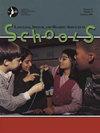言语治疗师的自我效能感和工作满意度:特殊教育资格决定中的资源。
IF 2.9
3区 医学
Q1 AUDIOLOGY & SPEECH-LANGUAGE PATHOLOGY
Language Speech and Hearing Services in Schools
Pub Date : 2024-09-10
DOI:10.1044/2024_lshss-23-00195
引用次数: 0
摘要
本研究以资源保护理论为基础,试图了解自我效能感、工作满意度、工作量大小和地理位置等资源如何影响学校语言病理学家(SLPs)在确定资格时所使用的数据源数量。方法采用横截面描述性设计,来自美国的 665 名学校语言病理学家报告了职业人口统计、工作量和评估/资格特征,以及工作满意度和自我效能感水平。研究采用多元回归法来检验自我效能感、工作满意度、案例数量和地理位置对资格决策中使用的数据源数量的影响,并检验案例数量和工作满意度资源对SLP自我效能感的影响。结果SLP平均使用7.98个数据源来支持资格决策。使用最多的是标准化测试、谈话样本和记录审查,使用最少的是读写能力评估。多元回归模型的结果表明,自我效能感得分较高的SLP使用的数据源明显较多,工作满意度较高的SLP的自我效能感明显较高。尽管语言康复师在教育环境中扮演着重要角色,但报告的识字评估有限。工作满意度是自我效能感的预测因素,而自我效能感反过来又是数据来源的预测因素,这突出表明,SLP 需要倡导支持其工作的工作条件。本文章由计算机程序翻译,如有差异,请以英文原文为准。
Speech-Language Pathologist Self-Efficacy and Job Satisfaction: Resources in Special Education Eligibility Decisions.
PURPOSE
Situated within the conservation of resources theory, this study sought to understand how resources such as self-efficacy, job satisfaction, caseload size, and geographic location influence the number of data sources used by school-based speech-language pathologists (SLPs) to determine eligibility.
METHOD
Using a cross-sectional descriptive design, 665 school-based SLPs from the United States reported professional demographics, workload, and assessment/eligibility characteristics, as well as levels of job satisfaction and self-efficacy. Multiple regression was used to examine the effects of self-efficacy, job satisfaction, caseload size, and geographic location on the number of data sources used in eligibility decision making and to examine the effects of caseload size and job satisfaction resources on SLP self-efficacy.
RESULTS
SLPs, on average, reported using 7.98 data sources to support eligibility determinations. Standardized tests, conversation samples, and review of records were most used, and literacy assessments were used least. Results of multiple regression models indicate that SLPs with higher self-efficacy scores reported using significantly more data sources and that SLPs with higher job satisfaction indicated significantly higher self-efficacy.
CONCLUSIONS
This study affirms self-efficacy as a strong resource for school-based SLPs and that it is, in fact, related to the number of data sources used in eligibility decisions. Limited literacy assessment was reported, despite the SLP's critical role in an educational setting. Job satisfaction as a predictor of self-efficacy and self-efficacy, in turn, as a predictor of data sources underscore the need for SLPs to advocate for work conditions that support their work.
求助全文
通过发布文献求助,成功后即可免费获取论文全文。
去求助
来源期刊

Language Speech and Hearing Services in Schools
Social Sciences-Linguistics and Language
CiteScore
4.40
自引率
12.50%
发文量
165
期刊介绍:
Mission: LSHSS publishes peer-reviewed research and other scholarly articles pertaining to the practice of audiology and speech-language pathology in the schools, focusing on children and adolescents. The journal is an international outlet for clinical research and is designed to promote development and analysis of approaches concerning the delivery of services to the school-aged population. LSHSS seeks to advance evidence-based practice by disseminating the results of new studies as well as providing a forum for critical reviews and meta-analyses of previously published work.
Scope: The broad field of audiology and speech-language pathology as practiced in schools, including aural rehabilitation; augmentative and alternative communication; childhood apraxia of speech; classroom acoustics; cognitive impairment; craniofacial disorders; fluency disorders; hearing-assistive technology; language disorders; literacy disorders including reading, writing, and spelling; motor speech disorders; speech sound disorders; swallowing, dysphagia, and feeding disorders; voice disorders.
 求助内容:
求助内容: 应助结果提醒方式:
应助结果提醒方式:


